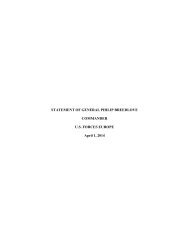FULLTEXT01
FULLTEXT01
FULLTEXT01
You also want an ePaper? Increase the reach of your titles
YUMPU automatically turns print PDFs into web optimized ePapers that Google loves.
TACTICAL THOUGHT<br />
2014 September 29 th<br />
Halhlweg uses the term Guerrilla Warfare as a cover for resistance, insurgency and a<br />
complement to Regular Warfare. Kitson and Thompson use the terms subversion and<br />
Insurgency as overarching terms for non-armed respectively armed violence/attacks on<br />
the government. McCuen´s “Counter-revolutionary Warfare” covers; Counter<br />
Organization, Counter Terrorism, Counter Guerrilla Warfare and Counter Mobile<br />
Warfare. Trinquir uses the term “Modern Warfare” as an umbrella term for Irregular<br />
Warfare. Galula, Kitson, Thompson and Trinquir address both sides of the struggle.<br />
Hahlweg mostly focuses on the irregular side and McCuen vice versa, on the defenders’<br />
side. All experts write with a clear focus on the military activities, with Thompson<br />
primarily viewing the strategic horizon and Hahlweg the tactical perspective. Trinquir<br />
addresses the military perspective predominantly in contrast to Thompson, who<br />
predominantly focuses on political/civilian perspectives, such as organization and<br />
administration. This is followed by McCuen, who conversely has a military focus.<br />
Galula views these perspectives equally for both parties where Trinquir and Kitson<br />
mostly write from the aggressors’ perspective.<br />
Answers to the three questions<br />
The first question; “How is the form of warfare, labelled Irregular Warfare defined and<br />
explained” can be summarized in general, despite different names, to be understood as<br />
including different forms of uprisings (revolutionary or against an occupier) or a<br />
complement to Regular Warfare. A specific character of this form of violence is stated<br />
to include the lower span – from subversion and sabotage via terrorism and Guerrilla<br />
Warfare with classic ingredients such as flank attacks and harassment to mobile<br />
warfare. The political aspect of the struggle with vital needs for support from the people<br />
is often highlighted. Means and methods are physically very different from the actual<br />
forms or military Regular Warfare. A main character is that military force and seeking<br />
the decisive battle is not a goal or possibility here. Both actions from irregulars and<br />
against such enemies are included. All descriptions focus on Irregular Warfare as a<br />
specific form of warfare, excluding Hahlweg, who includes such explanations as a<br />
complement to Regular Warfare.<br />
The second question; “What is said to distinguish Irregular Warfare from other forms of<br />
warfare” can be summarized with following aspects mentioned in the texts; limited<br />
physical strength, crushing of social structures, room-aspect, the human perspective, the<br />
anonymous fight, high versatility and different forms of tactics are factors argued as<br />
being different from Regular Warfare. The power and brutal consequences of terror and<br />
involving the “people” in this sort of warfare differs from Regular Warfare performed<br />
by soldiers, only because of higher levels of moral and ethical behaviour and standards.<br />
Another difference is stated to be a generally low interest from the military side in this<br />
form of warfare. The almost complete focus on ground combat differs from the Regular<br />
Warfare focus, which is on joint operations.<br />
51





